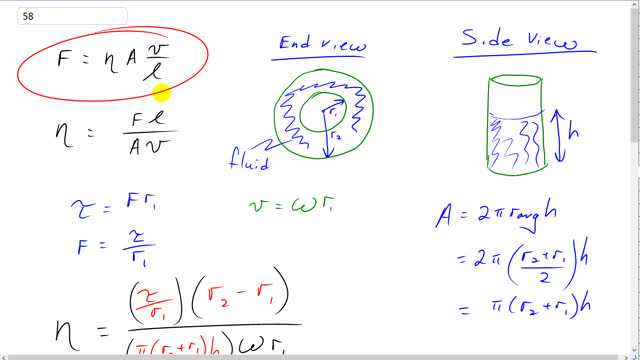
A viscometer consists of two concentric cylinders, 10.20 cm and 10.60 cm in diameter. A liquid fills the space between them to a depth of 12.0 cm. The outer cylinder is fixed, and a torque of keeps the inner cylinder turning at a steady rotational speed of 57 rev/min. What is the viscosity of the liquid?

In order to watch this solution you need to have a subscription.
This is Giancoli Answers with Mr. Dychko. We have this formula here for the force required to move a top plate when there's a fluid between it and a plate below it and that equals this η this coefficient of viscosity that we have to find multiplied by the area of the plate times the speed that it's being moved at divided by the separation between the plates. So this formula isn't precisely made for our scenario: in this question which has cylinders instead of plates but we can use it approximately and I'll show you what I mean by that. So let's rearrange this formula though to solve for the coefficient of viscosity and we'll multiply both sides by l and divide by Av and we end up with η which is coefficient of viscosity equals Fl over A times v. So we need to know the force required to move one of the plates so we'll consider this inner cylinder surface to be the plate that's being moved and this outer cylinder surface is the plate that's stationary and so the force is being applied on the inner plate then and that force would be torque divided by the inner plate radius, r 1. Here's the torque formula: force times lever arm and solve it for force by dividing both sides by r 1 so we are gonna substitute that in place of F in just a moment. Then we need to know the speed that this plate being moved is going and so, in other words, what is the tangental velocity of a point here on this inner cylinder and that would be the angular velocity times the r 1—radius of this inner cylinder— and then what is the area? Well, this is the end view showing one cylinder nested within a larger cylinder and there's fluid in this space in between the cylinders and then a side view shows the cylinders being stood up and there the fluid goes up a height of 12 centimeters we are told. So the area then is gonna be well, area of a cylinder is the circumference of a cylinder times its height and we are gonna use the average radius because this is the only point where where this formula which is made for, you know, two flat plates doesn't precisely apply; we have to make this approximation that the area we are dealing with is gonna be this 2π times the average radius between these two cylinders. And that's not a bad approximation because the radii are almost the same; they differ by very little... it's 10.6 centimeters for one of them and 10.2 centimeters for the other so their percent difference in radii is very small so this r average should be good enough. So that's r 2 plus r 1 over 2 and this is what we'll consider to be the area in contact with the fluid. So the 2's cancel here by the way— that's nice— so the area is πr 2 plus r 1 times h. And so then we substitute a whole bunch of things here in this formula for η. So we have torque over radius 1 is the force; we have r 2 minus r 1 is l, I didn't write that here anyway but that's the difference between these two surfaces, r 2 minus r 1, and that's divided by π times r 2 plus r 1 times h, that's the substitution for area, and then the velocity is ω times r 1. Okay, so basically everything got substituted that time and we then we clean it up a little bit: this r 1 on top we can multiply, you know, top and bottom by r 1 and that gets rid of the r 1 on top and ends up with an r 1 squared on the bottom and that's the only thing I did there otherwise just rewriting it and then since we are given diameter's in the question, let's replace all these radii with diameter so r 2 is d 2 over 2 and r 1 is d 1 over 2 and same story here and as well as in here, we have d 1 over 2 all squared and this common factor a half here can get factored out and on the denominator, there's also a common factor one-half so those cancel each other out and we are left with in the end, just the factor one quarter in the bottom but then multiply top and bottom by 4 to cancel the quarter in the bottom leaving us with this 4 on top. So we have 4 times torque times d 2 minus d 1 over π times d 1 squared times angular velocity times height times the sum of the diameter's. So we have 4 times 0.24 newton meters—torque—times 0.1060 meters—diameter for the outer cylinder—minus 0.1020 meters—for the inner diameter— divided by π times 0.1020 meters squared times 57 revolutions per minute converted into radians per second in order to use in any of our formulas so we'll multiply by 2π radians for every revolution then times by 1 minute for every 60 seconds giving us radians per second times by 0.120 meters—of height— and then times the sum of the diameter's and in the calculator, it all looks like this and we have about 7.9 times 10 to the minus 2 pascal seconds is the viscosity of this fluid.